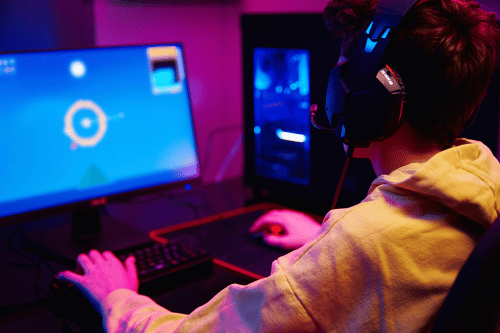Screen Addiction in Youth: Understanding and Managing the Impact
Screen addiction in youth, driven by the pervasive use of screen media, is an escalating issue in modern society. With digital devices becoming essential tools for education, entertainment, and communication, children and adolescents are increasingly exposed to screens. However, the excessive use of these technologies has raised concerns among parents, educators, and mental health professionals. Whether it’s playing video games or scrolling through social media, unregulated screen use has the potential to disrupt emotional, cognitive, and physical development.
This article explores what screen addiction is, how it impacts young people, the signs and symptoms to look for, and actionable strategies to manage and prevent it.
What is Screen Addiction?

Screen addiction refers to the compulsive and unhealthy engagement with digital devices, including smartphones, tablets, computers, and video game consoles. It occurs when children find it difficult to stop using screens, even when it negatively affects their routines, relationships, and responsibilities. A typical example of screen addiction in youth involves children playing video games excessively, leading to negative consequences in their academic performance and mental well-being.
Mental health experts often compare screen addiction to other addictive behaviors, such as internet addiction or substance abuse. It can trigger the same brain responses associated with pleasure, gratification, and dependency, making it challenging for children’s brains to self-regulate their usage.
Internet Gaming Disorder: A Growing Concern
A specific manifestation of screen addiction is internet gaming disorder, often referred to as video game addiction, where individuals become preoccupied with online games or video games. Children with this disorder may prioritize gaming over essential activities such as eating, sleeping, or spending time with family and friends. The American Psychiatric Association classifies this as a mental health condition requiring professional intervention.
The overstimulation from playing video games can rewire children’s brains to seek constant rewards, impairing their impulse control and fostering patterns of instant gratification. These behaviors interfere with their academic progress, relationships, and overall mental health.

Causes of Excessive Screen Time
Excessive screen time in youth is a complex issue influenced by various factors. The widespread availability of digital devices makes it easy for children to access screen-based entertainment at any time. The allure of instant gratification and constant stimulation from screens can create a pattern of behavior that is hard to break. Without adequate parental guidance, children may find themselves spending more time on screens than is healthy.
Screens often serve as a coping mechanism for children dealing with stress, anxiety, or other emotional issues. The immersive nature of digital media can provide a temporary escape from real-life problems, making it an attractive option for those seeking comfort.
Several other factors contribute to excessive screen time:
Screens as Babysitters: Parents may use screens to keep children occupied, especially when they need to focus on other tasks.
Lack of Physical Activity: With fewer opportunities for outdoor play, children may turn to screens for entertainment.
Screens in Bedrooms: The presence of screens in children’s bedrooms can make it difficult for them to wind down and fall asleep, leading to prolonged screen use.
Screens as Rewards or Punishments: Using screens as a reward or punishment can reinforce their importance in children’s lives.
Peer and Social Media Influence: The pressure to stay connected with peers and keep up with social media trends can drive children to spend more time on screens.
Understanding these causes is the first step in addressing excessive screen time and promoting healthier habits.
The Impact of Screen Addiction on Youth

The effects of screen addiction in youth extend beyond just behavioral issues. Unlike adult brains, which are more developed and capable of exercising impulse control, children’s brains are more vulnerable to the negative impacts of excessive screen time. It affects children’s physical health, mental well-being, and social development. Below are some of the most common negative consequences:
1. Mental Health Issues
Children suffering from screen addiction are more prone to mental health conditions such as anxiety, depression, and even attention deficit hyperactivity disorder (ADHD). Overexposure to social media can contribute to feelings of inadequacy, leading to negative feelings and lower self-esteem. In extreme cases, children might require professional support from mental health professionals.
2. Disrupted Sleep Patterns and Poor Sleep Quality
Excessive screen time, especially before bed, can lead to inconsistent sleep patterns and poor sleep quality. The blue light emitted by screens disrupts the natural circadian rhythm, making it difficult for children to fall asleep. Poor sleep can cause mood swings, cognitive impairment, and chronic fatigue, which can affect school performance and emotional regulation.
3. Social Isolation and Behavioral Changes
Spending excessive time on digital platforms often leads to social isolation, as children interact less with peers and family members. They may also develop socially unacceptable impulses or struggle with maintaining social interactions in real life. Mental health professionals highlight that screen addiction may result in behaviors such as avoiding social gatherings, exhibiting mood swings, or becoming irritable when screens are taken away.
4. Physical Health Issues
Prolonged screen use can lead to various physical problems, including vision problems, neck pain, and weight gain due to sedentary behavior. Children may also neglect outdoor activities and physical fitness, further affecting their health.
Understanding the Role of Digital Media in Youth Development
The introduction of digital media into children’s lives is inevitable, but understanding screen addiction and how to manage it is critical. While digital platforms provide numerous educational and recreational benefits, unregulated screen use can be harmful, particularly for children younger than 12.
Brain Development and Screen Use
Research shows that children’s brains are highly plastic, meaning they are more impressionable during early development stages. Overexposure to screens can interfere with brain circuits related to impulse control and emotional regulation, increasing the risk of addictive behaviors. Healthy brain development requires balancing screen activities with other stimulating activities such as playing board games, engaging in physical activities, and having meaningful conversations with family.
How to Recognize Screen Addiction Symptoms
Identifying screen addiction symptoms early can prevent long-term consequences. Here are some common warning signs parents should watch for:
Mood swings and irritability when access to digital devices is restricted
Inconsistent sleep patterns and fatigue due to late-night screen use
A decrease in academic performance or lack of interest in hobbies
Withdrawal from friends and family, leading to social isolation
Physical symptoms like vision problems or neck pain
Children exhibiting these symptoms may benefit from the involvement of mental health professionals, who can help them establish healthier routines and regain balance.
Strategies for Managing and Preventing Screen Addiction
Preventing screen addiction in youth requires proactive strategies and consistent rules around screen use. Here are several approaches families can adopt:
1. Place Consistent Limits on Screen Time
Setting clear rules about daily screen time is essential. For instance, families can allocate media-free times during meals or before bedtime. Monitoring screen time helps children understand boundaries and promotes healthy digital habits.
2. Encourage High-Quality Programming
Instead of banning screens entirely, parents can introduce digital media selectively, focusing on high-quality programs that promote learning and creativity. Platforms like Common Sense Media offer recommendations for age-appropriate content that aligns with developmental goals.
3. Promote Physical Activities and Social Interactions
Encouraging children to engage in physical activities, such as sports or playing board games, helps them develop essential life skills and maintain physical fitness. Additionally, fostering social interactions with peers builds communication skills and reduces the risk of social isolation.
4. Foster Ongoing Communication with Children
Maintaining ongoing communication about the impact of screen use is crucial. Children should understand the value of balancing online activities with offline experiences. Parents can also co-view media with their children, discussing what they watch and encouraging thoughtful reflection on content.
Treatment Options
Addressing screen addiction and excessive screen time requires a multifaceted approach that combines behavioral interventions, education, and support. The primary goal of treatment is to help children and families develop healthy screen use habits and mitigate the negative consequences of excessive screen time.
Common treatment options include:
Cognitive-Behavioral Therapy (CBT): This therapy helps children identify and change negative thought patterns and behaviors associated with screen use. By developing healthier coping mechanisms, children can reduce their reliance on screens.
Family Therapy: Involving the entire family in therapy can help parents and caregivers develop effective strategies for managing screen time and promoting healthy habits. Family therapy fosters a supportive environment where everyone works together towards common goals.
Educational Programs: These programs teach children and families about the risks and consequences of excessive screen time. By raising awareness, educational programs empower families to make informed decisions about screen use.
Support Groups: Connecting with others who are facing similar challenges can provide a sense of community and support. Support groups offer a platform for sharing experiences, advice, and encouragement.
Alternative Activities and Hobbies: Encouraging children to explore new interests and skills can help them find fulfillment outside of screens. Activities such as sports, arts, and crafts provide healthy alternatives to screen time.
By combining these treatment options, families can create a comprehensive plan to address screen addiction and promote overall well-being.
Breaking the Cycle of Screen Addiction
Breaking the cycle of screen addiction requires a comprehensive approach that involves the entire family. Here are some strategies that can help:
Set Clear Rules and Limits: Establishing and enforcing consistent rules about screen time is crucial. For example, designate media-free times during meals and before bedtime to encourage healthier habits.
Encourage Physical Activity and Outdoor Play: Physical activities and outdoor play are essential for children’s development. Encourage your child to participate in sports, play outside, or engage in other physical activities to reduce screen time.
Engage in Alternative Activities and Hobbies: Introduce your child to new hobbies and interests that do not involve screens. Activities like playing board games, reading, or pursuing creative arts can provide fulfilling alternatives.
Monitor Screen Time: Keep track of the amount of time your child spends on screens and set limits accordingly. Use tools and apps designed to help monitor and manage screen time effectively.
Educate Your Child: Talk to your child about the risks and consequences of excessive screen time. Help them understand the importance of balancing screen use with other activities.
Seek Professional Help: If you suspect that your child is struggling with screen addiction, do not hesitate to seek professional help. Mental health professionals can provide guidance and support tailored to your child’s needs.
Parents can also model healthy screen use habits themselves by:
Limiting Their Own Screen Time: Show your child that you prioritize other activities over screens.
Engaging in Alternative Activities: Participate in hobbies and activities that do not involve screens, setting a positive example for your child.
Setting Clear Boundaries: Establish and adhere to rules for screen use within the household.
Encouraging Physical Activity: Be active and encourage your child to join you in physical activities.
Monitoring Screen Time: Keep an eye on your own screen use and make adjustments as needed.
By working together and taking a comprehensive approach, families can break the cycle of screen addiction and develop healthy screen use habits that promote physical and mental well-being.
The Role of Schools and Mental Health Professionals
Schools and mental health professionals play a pivotal role in addressing screen addiction symptoms. Teachers can help by promoting media-free times in classrooms and encouraging activities that enhance attention and critical thinking. Schools should also educate children about the risks of problematic internet use and digital addiction.
For children struggling with internet gaming disorder or other forms of screen addiction, third-party programs and counseling services can provide specialized support. Mental health providers work with families to design personalized intervention plans, helping children regain control over their screen habits.
Conclusion
Screen addiction in youth is a pressing issue that requires collective effort from parents, educators, and healthcare providers. While digital devices are essential tools in today’s world, unregulated use can lead to serious negative consequences for children’s mental and physical well-being.
By establishing consistent rules, encouraging high-quality programming, promoting physical fitness, and fostering open communication, families can mitigate the risks of screen addiction. Early intervention and collaboration with mental health professionals are critical to helping children develop a healthy relationship with technology.









